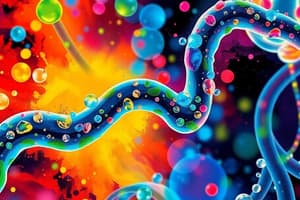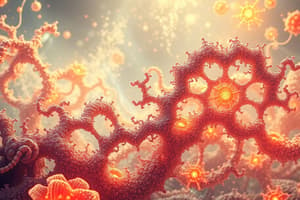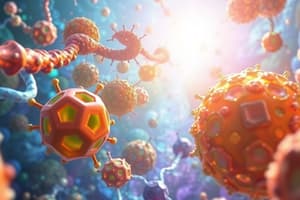Podcast
Questions and Answers
What is the role of Gibbs free-energy function G in predicting chemical reactions?
What is the role of Gibbs free-energy function G in predicting chemical reactions?
It allows prediction of the direction of chemical reactions, their equilibrium position, and the work they can perform.
How do heterotrophic and photosynthetic cells acquire free energy?
How do heterotrophic and photosynthetic cells acquire free energy?
Heterotrophic cells acquire it from nutrient molecules, while photosynthetic cells obtain it from absorbed solar radiation.
What is the effect of enzymes on the activation energy of a reaction?
What is the effect of enzymes on the activation energy of a reaction?
Enzymes lower the activation energy, allowing reactions to proceed more quickly at body temperature.
Can enzymes change the equilibrium constant of a reaction?
Can enzymes change the equilibrium constant of a reaction?
What principle explains how an endergonic reaction can be driven forward?
What principle explains how an endergonic reaction can be driven forward?
What is the significance of the standard free-energy change being additive in sequential reactions?
What is the significance of the standard free-energy change being additive in sequential reactions?
How does the synthesis of glucose 6-phosphate relate to its free-energy change?
How does the synthesis of glucose 6-phosphate relate to its free-energy change?
Describe the difference between anabolic and catabolic processes in metabolism.
Describe the difference between anabolic and catabolic processes in metabolism.
What is the first law of thermodynamics?
What is the first law of thermodynamics?
Explain the second law of thermodynamics in simple terms.
Explain the second law of thermodynamics in simple terms.
What role does NADH play in cellular metabolism?
What role does NADH play in cellular metabolism?
Describe the concept of bioenergetics.
Describe the concept of bioenergetics.
What distinguishes anabolic processes from catabolic processes?
What distinguishes anabolic processes from catabolic processes?
How do cells regulate enzyme activity?
How do cells regulate enzyme activity?
What does free energy (G) represent in thermodynamics?
What does free energy (G) represent in thermodynamics?
Why are living systems considered open systems?
Why are living systems considered open systems?
What is meant by energy transduction in cells?
What is meant by energy transduction in cells?
How do living organisms create order while adhering to the second law of thermodynamics?
How do living organisms create order while adhering to the second law of thermodynamics?
What role do intermediates, enzymes, and regulators play in metabolic pathways?
What role do intermediates, enzymes, and regulators play in metabolic pathways?
How is the activity of key enzymes in metabolic pathways typically regulated?
How is the activity of key enzymes in metabolic pathways typically regulated?
What is the significance of ATP in cellular metabolism?
What is the significance of ATP in cellular metabolism?
Describe the process by which energy-requiring reactions are powered in cells.
Describe the process by which energy-requiring reactions are powered in cells.
How do oxidation-reduction reactions contribute to ATP production?
How do oxidation-reduction reactions contribute to ATP production?
Explain the concept of energy transduction in living organisms.
Explain the concept of energy transduction in living organisms.
What is the relationship between free energy change and work in chemical reactions?
What is the relationship between free energy change and work in chemical reactions?
How do growth factors and hormones influence metabolic activity in multicellular organisms?
How do growth factors and hormones influence metabolic activity in multicellular organisms?
Distinguish between anabolic and catabolic processes in metabolism.
Distinguish between anabolic and catabolic processes in metabolism.
What is the consequence of having separate pools of anabolic and catabolic intermediates?
What is the consequence of having separate pools of anabolic and catabolic intermediates?
What is the significance of a negative ΔG in a chemical reaction?
What is the significance of a negative ΔG in a chemical reaction?
How do exothermic and endothermic reactions differ in terms of enthalpy change (ΔH)?
How do exothermic and endothermic reactions differ in terms of enthalpy change (ΔH)?
What role does entropy (ΔS) play in determining the spontaneity of a reaction?
What role does entropy (ΔS) play in determining the spontaneity of a reaction?
What distinguishes anabolic processes from catabolic processes in metabolism?
What distinguishes anabolic processes from catabolic processes in metabolism?
How does temperature influence the Gibbs free energy change (ΔG) for biochemical reactions?
How does temperature influence the Gibbs free energy change (ΔG) for biochemical reactions?
What is the standard free-energy change, ΔG′°, and how is it calculated for a reaction?
What is the standard free-energy change, ΔG′°, and how is it calculated for a reaction?
Explain how bioenergetics relates to metabolism.
Explain how bioenergetics relates to metabolism.
Distinguish between anabolic and catabolic processes.
Distinguish between anabolic and catabolic processes.
What role does ATP hydrolysis play in metabolic reactions?
What role does ATP hydrolysis play in metabolic reactions?
How does the change in free energy, ΔG, relate to the stability of reactants and products?
How does the change in free energy, ΔG, relate to the stability of reactants and products?
Why is the actual free-energy change, ΔG, variable, while ΔG′° is a constant?
Why is the actual free-energy change, ΔG, variable, while ΔG′° is a constant?
What is the significance of the term 'energy transduction' in the context of cellular metabolism?
What is the significance of the term 'energy transduction' in the context of cellular metabolism?
How does the concept of entropy (S) factor into biological reactions?
How does the concept of entropy (S) factor into biological reactions?
In metabolic pathways, how do positive and negative values of ΔG′° influence reaction direction?
In metabolic pathways, how do positive and negative values of ΔG′° influence reaction direction?
What is the relationship between hydrolysis of ATP and the synthesis of glucose 6-phosphate?
What is the relationship between hydrolysis of ATP and the synthesis of glucose 6-phosphate?
Flashcards are hidden until you start studying
Study Notes
Bioenergetics
- Gibbs free energy (G): determines the direction of chemical reactions, their equilibrium position, and the amount of work they can theoretically do at constant temperature and pressure.
- Heterotrophic cells acquire free energy from nutrient molecules.
- Photosynthetic cells acquire free energy from absorbed solar radiation.
- Cells transform free energy into ATP and other energy-rich compounds to provide energy for biological work.
Enzyme Catalysis
- Uncatalyzed reactions in cells are slow.
- Enzymes lower activation energy providing an alternative reaction pathway, allowing more substrate molecules to overcome the activation barrier.
- Enzymes cannot change equilibrium constants, but they can increase the rate of a reaction in the direction dictated by thermodynamics.
Standard Free-Energy Changes
- Sequential reactions have their own equilibrium constants and characteristic standard free-energy changes.
- The standard free-energy change of the overall reaction is the sum of the standard free-energy changes of the individual reactions.
Coupling Endergonic and Exergonic Reactions
- An endergonic reaction can be driven in the forward direction by coupling it to a highly exergonic reaction.
- Phosphoryl transfer from ATP is an example of energy coupling.
- The hydrolysis of ATP to ADP and Pi is highly exergonic, providing energy for muscle contraction, solute pumping, and biosynthesis.
Thermodynamics of Energy Transductions
- Bioenergetics studies energy transductions in biological systems.
- Biological energy transformations obey the laws of thermodynamics.
- The first law of thermodynamics: energy is conserved, it can change forms or be transported, but not created or destroyed.
- The second law of thermodynamics: the universe tends toward increasing disorder, entropy increases in natural processes.
Open Biological Systems
- Cells and organisms are open systems, exchanging material and energy with their surroundings.
- The constant exchange between a system and its surroundings enables organisms to create order within themselves while adhering to the second law of thermodynamics.
Thermodynamics of Chemical Reactions
- Free energy (G): the amount of energy capable of doing work during a reaction at constant temperature and pressure.
- Enthalpy (H): the heat content of the reacting system, reflecting the number and types of chemical bonds.
- Entropy (S): a quantitative measure of randomness or disorder in a system.
Relationship Between Energy Changes
- The free-energy change (ΔG), enthalpy change (ΔH), and entropy change (ΔS) are related by the equation: ΔG = ΔH - T ΔS.
- ΔG is always negative for a spontaneous reaction.
- Cells are isothermal systems, functioning at constant temperature and pressure. Heat flow cannot be used to do work in cells.
Regulation of Metabolic Pathways
- Cells regulate enzyme activities by changing the number of enzyme molecules or their catalytic activity.
- Metabolic pathways are regulated at multiple levels, including within the cell and from outside.
- Different compartments within cells maintain different concentrations, allowing for control of metabolic rates.
Summary
- Bioenergetics is the study of energy relationships and conversions in biological systems.
- Biological energy transformations obey the laws of thermodynamics, including the conservation of energy and the increase of entropy.
- Cells require energy for essential functions like maintaining structure, biosynthesis, transport, and generation of electric currents.
- Cells utilize the energy stored in ATP to perform biological work, and this energy is derived from the oxidation of fuel molecules.
- Coupling of exergonic and endergonic reactions allows cells to drive unfavorable reactions using the energy released from favorable ones.
- Standard free-energy changes are additive, allowing for the calculation of the overall free-energy change for a series of reactions.
- Maintaining life requires constant energy input, as cells are open systems that must exchange energy with their environment to maintain order and perform work.
Studying That Suits You
Use AI to generate personalized quizzes and flashcards to suit your learning preferences.




